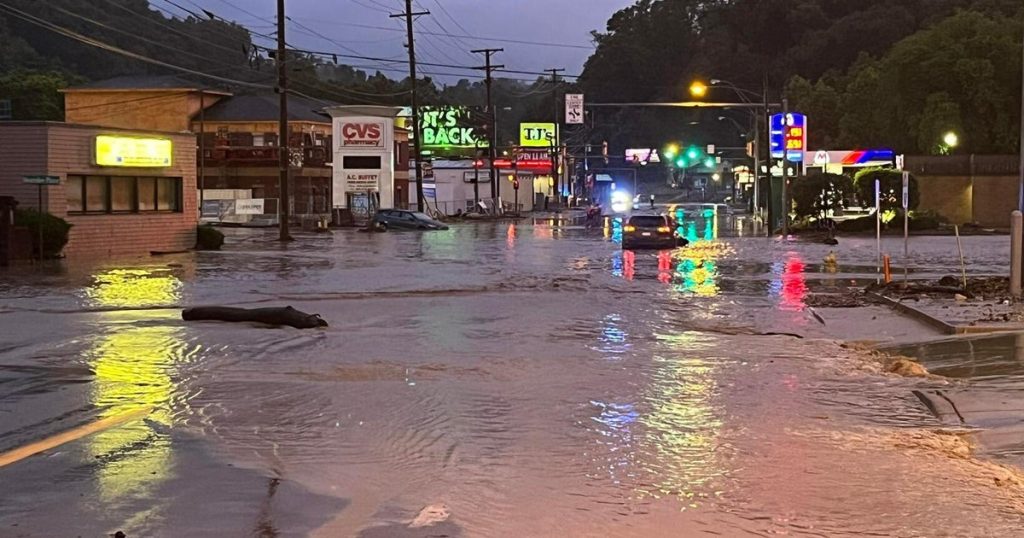A devastating flash flood in northern West Virginia has resulted in the deaths of four individuals, including a young child. The heavy rainfall, which hit on Saturday night, overwhelmed local waterways and infrastructure, leading to numerous rescues and a search for several missing persons. Officials are now assessing the damage and preparing for potential further flooding as conditions continue to evolve.
| Article Subheadings |
|---|
| 1) Overview of the Flash Flood Incident |
| 2) Emergency Response Efforts |
| 3) State of Emergency Declaration |
| 4) Infrastructure Damage and Rescue Operations |
| 5) Regional Weather Conditions and Impacts |
Overview of the Flash Flood Incident
On Saturday night, severe weather wreaked havoc in northern West Virginia, with reports indicating rainfall amounts ranging from 2.5 to 4 inches within just half an hour. This intense downpour led to catastrophic flooding in parts of Wheeling and Ohio County, inundating vehicles in small towns such as Triadelphia and Valley Grove. The rapid flooding claimed the lives of four residents, including a tragic fatality involving a 3-year-old child.
As the floodwaters rose unexpectedly, they overwhelmed both natural waterways and man-made drainage systems, resulting in submerged vehicles and blocked roadways. Local officials and first responders rushed to the scene as multiple 911 calls flooded in, signaling the urgency of the situation. Rescue operations began almost immediately, with citizens and professionals alike scrambling to safety and searching for those trapped by the rising waters.
Emergency Response Efforts
In the face of this calamity, swift actions were initiated by local emergency management officials. According to Lou Vargo, the emergency management director for Ohio County, the situation escalated rapidly. “We almost immediately started getting 911 calls for rescue of people being trapped,” he said during a news conference on Sunday, underscoring the scale of the emergency.
First responders undertook numerous swift-water rescues, with approximately 19 successful operations reported. Search and rescue teams, including fire and emergency personnel, worked through the night into the early morning hours to locate and assist those affected by the flooding. The cooperative efforts involved both local community members and dedicated organizations, showcasing the spirit of solidarity in such dire times.
State of Emergency Declaration
In response to the unprecedented flooding, West Virginia Governor Patrick Morrisey announced a state of emergency for Ohio County. During a news conference, he emphasized the seriousness of the situation and the urgent need for immediate support from state resources. The declaration facilitates expedited responses and access to federal assistance through organizations like FEMA.
The governor’s office has communicated with local officials to coordinate a robust response to not only address the immediate needs of the community but also to plan for potential follow-up recovery efforts. He urged residents to remain vigilant as the weather forecast anticipated further storms in the area, raising concerns about new waves of flooding.
Infrastructure Damage and Rescue Operations
The impact of the flooding extended beyond loss of life, as significant damage to infrastructure has been recorded. According to officials, critical roads, bridges, and highways were impacted, complicating access for emergency responders. Jim Blazier, fire chief in Wheeling, indicated that crews were focused on specific areas to conduct comprehensive searches, using advanced technology and rescue equipment to ensure safety and thoroughness in operations.
The priority of the first responders is to assess submerged vehicles and investigate debris along the waterways. Search dogs, drones, and swift water personnel have been deployed strategically to enhance the efficiency of the search. The coordination points to a well-organized response amid challenging conditions wrought by the flooding.
Regional Weather Conditions and Impacts
The flooding in West Virginia follows a series of heavy rainstorms that recently ravaged regions in adjacent states. Reports highlighted that similar weather patterns in San Antonio resulted in tragic consequences just a few days earlier, with at least 13 fatalities recorded there due to flash flooding as well.
Officials are urging the community to remain alert, advising them to avoid driving through flooded roads and to heed all warnings issued by local authorities. The continuous downpours pose ongoing threats to public safety, and proactivity in dissemination of information and directives will be crucial in preventing further tragedy.
| No. | Key Points |
|---|---|
| 1 | Flash flooding in northern West Virginia led to four confirmed deaths, including a child. |
| 2 | Emergency responders executed 19 swift water rescues amid increasing water levels. |
| 3 | Governor Morrisey declared a state of emergency to facilitate restoration and recovery efforts. |
| 4 | Damage assessment of infrastructure continues as rescuers search submerged vehicles and debris. |
| 5 | The recent weather patterns have raised safety concerns in multiple states due to flooding risks. |
Summary
The tragic flooding in northern West Virginia represents a significant natural disaster that has led to loss of life and widespread infrastructural damage. Urgent response efforts by local officials and emergency responders have highlighted both the resilience of the community and the importance of preparedness for such disasters. As weather predictions indicate further rain, continued vigilance and proactive measures will be essential in protecting the lives and properties of residents in the affected areas.
Frequently Asked Questions
Question: What caused the flooding in northern West Virginia?
The flooding was primarily caused by a significant rainfall event, with reports indicating 2.5 to 4 inches falling in a short period, overwhelming local waterways and drainage systems.
Question: How are rescue operations being conducted?
Rescue operations are being conducted by local emergency responders using a combination of swift-water rescue teams, drones, search dogs, and other advanced technologies to locate and assist those in need.
Question: What is the current state of infrastructure in the affected areas?
Infrastructure such as roads and bridges has suffered considerable damage from the flooding, complicating rescue efforts and necessitating ongoing assessments by local officials.


